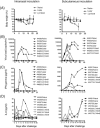LC16m8, a highly attenuated vaccinia virus vaccine lacking expression of the membrane protein B5R, protects monkeys from monkeypox
- PMID: 16698998
- PMCID: PMC1472157
- DOI: 10.1128/JVI.02642-05
LC16m8, a highly attenuated vaccinia virus vaccine lacking expression of the membrane protein B5R, protects monkeys from monkeypox
Abstract
The potential threat of smallpox as a bioweapon has led to the production and stockpiling of smallpox vaccine in some countries. Human monkeypox, a rare but important viral zoonosis endemic to central and western Africa, has recently emerged in the United States. Thus, even though smallpox has been eradicated, a vaccinia virus vaccine that can induce protective immunity against smallpox and monkeypox is still invaluable. The ability of the highly attenuated vaccinia virus vaccine strain LC16m8, with a mutation in the important immunogenic membrane protein B5R, to induce protective immunity against monkeypox in nonhuman primates was evaluated in comparison with the parental Lister strain. Monkeys were immunized with LC16m8 or Lister and then infected intranasally or subcutaneously with monkeypox virus strain Liberia or Zr-599, respectively. Immunized monkeys showed no symptoms of monkeypox in the intranasal-inoculation model, while nonimmunized controls showed typical symptoms. In the subcutaneous-inoculation model, monkeys immunized with LC16m8 showed no symptoms of monkeypox except for a mild ulcer at the site of monkeypox virus inoculation, and those immunized with Lister showed no symptoms of monkeypox, while nonimmunized controls showed lethal and typical symptoms. These results indicate that LC16m8 prevents lethal monkeypox in monkeys, and they suggest that LC16m8 may induce protective immunity against smallpox.
Figures





Similar articles
-
LC16m8: an attenuated smallpox vaccine.Vaccine. 2006 Nov 17;24(47-48):7009-22. doi: 10.1016/j.vaccine.2006.03.087. Epub 2006 Apr 21. Vaccine. 2006. PMID: 17052815 Free PMC article. Review.
-
A Single Vaccination of Nonhuman Primates with Highly Attenuated Smallpox Vaccine, LC16m8, Provides Long-term Protection against Monkeypox.Jpn J Infect Dis. 2017 Jul 24;70(4):408-415. doi: 10.7883/yoken.JJID.2016.417. Epub 2016 Dec 22. Jpn J Infect Dis. 2017. PMID: 28003603
-
Vaccinia virus strain LC16m8 defective in the B5R gene keeps strong protection comparable to its parental strain Lister in immunodeficient mice.Vaccine. 2015 Nov 9;33(45):6112-9. doi: 10.1016/j.vaccine.2015.07.076. Epub 2015 Aug 1. Vaccine. 2015. PMID: 26241947
-
Smallpox DNA vaccine protects nonhuman primates against lethal monkeypox.J Virol. 2004 May;78(9):4433-43. doi: 10.1128/jvi.78.9.4433-4443.2004. J Virol. 2004. PMID: 15078924 Free PMC article.
-
Recent advances in the study of live attenuated cell-cultured smallpox vaccine LC16m8.Vaccine. 2015 Nov 9;33(45):6106-11. doi: 10.1016/j.vaccine.2015.07.111. Epub 2015 Aug 28. Vaccine. 2015. PMID: 26319072 Free PMC article. Review.
Cited by
-
Effect of the deletion of genes encoding proteins of the extracellular virion form of vaccinia virus on vaccine immunogenicity and protective effectiveness in the mouse model.PLoS One. 2013 Jun 13;8(6):e67984. doi: 10.1371/journal.pone.0067984. Print 2013. PLoS One. 2013. PMID: 23785523 Free PMC article.
-
Transmission of atypical varicella-zoster virus infections involving palm and sole manifestations in an area with monkeypox endemicity.Clin Infect Dis. 2009 Jan 1;48(1):e6-8. doi: 10.1086/595552. Clin Infect Dis. 2009. PMID: 19025497
-
A protein-based smallpox vaccine protects non-human primates from a lethal monkeypox virus challenge.Vaccine. 2010 Sep 14;28(40):6627-36. doi: 10.1016/j.vaccine.2010.07.030. Epub 2010 Jul 24. Vaccine. 2010. PMID: 20659519 Free PMC article.
-
LC16m8: an attenuated smallpox vaccine.Vaccine. 2006 Nov 17;24(47-48):7009-22. doi: 10.1016/j.vaccine.2006.03.087. Epub 2006 Apr 21. Vaccine. 2006. PMID: 17052815 Free PMC article. Review.
-
Construction and characterization of bacterial artificial chromosomes harboring the full-length genome of a highly attenuated vaccinia virus LC16m8.PLoS One. 2018 Feb 23;13(2):e0192725. doi: 10.1371/journal.pone.0192725. eCollection 2018. PLoS One. 2018. PMID: 29474493 Free PMC article.
References
-
- Cassimatis, D. C., J. E. Atwood, R. M. Engler, P. E. Linz, J. D. Grabenstein, and M. N. Vernalis. 2004. Smallpox vaccination and myopericarditis: a clinical review. J. Am. Coll. Cardiol. 43:1503-1510. - PubMed
-
- CDC. 2004. Update: adverse events following civilian smallpox vaccination—United States, 2003. Morb. Mortal. Wkly. Rep. 53:106-107. - PubMed
-
- Chen, N., G. Li, M. K. Liszewski, J. P. Atkinson, P. B. Jahrling, Z. Feng, J. Schriewer, C. Buck, C. Wang, E. J. Lefkowitz, J. J. Esposito, T. Harms, I. K. Damon, R. L. Roper, C. Upton, and R. M. Buller. 2005. Virulence differences between monkeypox virus isolates from West Africa and the Congo basin. Virology 340:46-63. - PMC - PubMed
-
- Chen, R. T., and J. M. Lane. 2003. Myocarditis: the unexpected return of smallpox vaccine adverse events. Lancet 362:1345-1346. - PubMed
-
- Cohen, J. 2002. Public health. Looking for vaccines that pack a wallop without the side effects. Science 298:2314. - PubMed
Publication types
MeSH terms
Substances
LinkOut - more resources
Full Text Sources
Medical

